coolant level Mercury Mystique 2000 Owner's Manuals
[x] Cancel search | Manufacturer: MERCURY, Model Year: 2000, Model line: Mystique, Model: Mercury Mystique 2000Pages: 248, PDF Size: 2.2 MB
Page 5 of 248
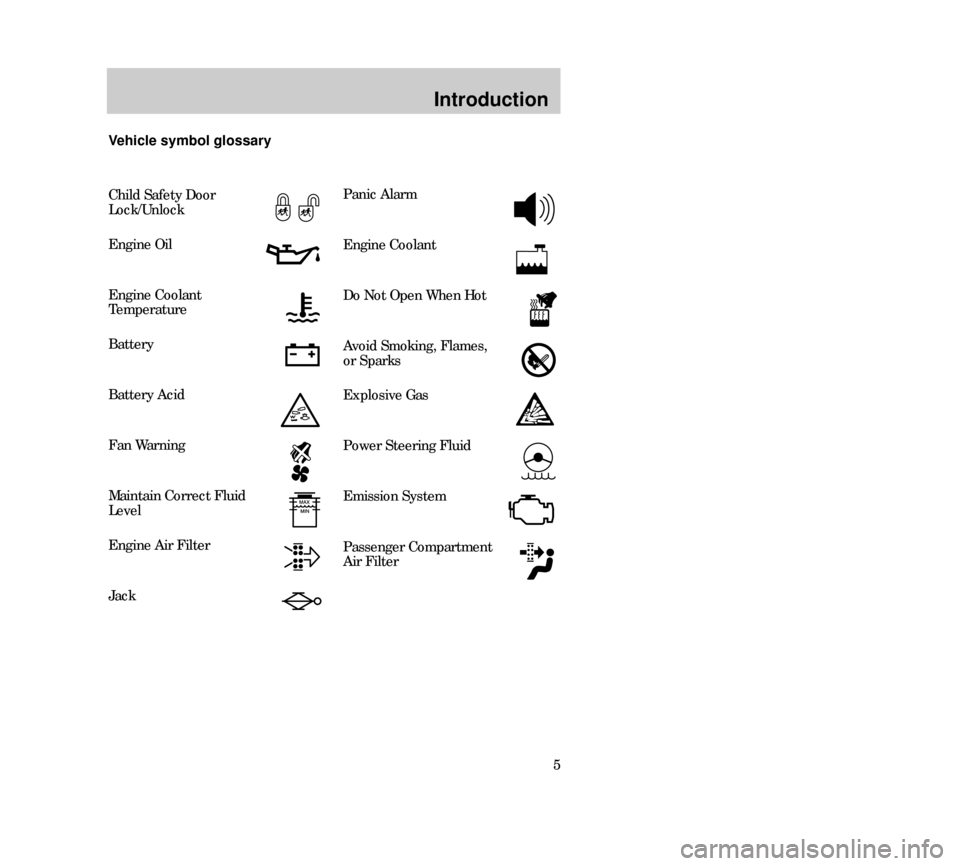
Introduction
5 Vehicle symbol glossary
Child Safety Door
Lock/Unlock
Engine Oil
Engine Coolant
Temperature
Battery
Battery Acid
Fan Warning
Maintain Correct Fluid
Level
Engine Air Filter
Jack
Panic Alarm
Engine Coolant
Do Not Open When Hot
Avoid Smoking, Flames,
or Sparks
Explosive Gas
Power Steering Fluid
Emission System
Passenger Compartment
Air Filter
11MIten 24.6.99 15:01 Uhr Seite 5
Page 11 of 248
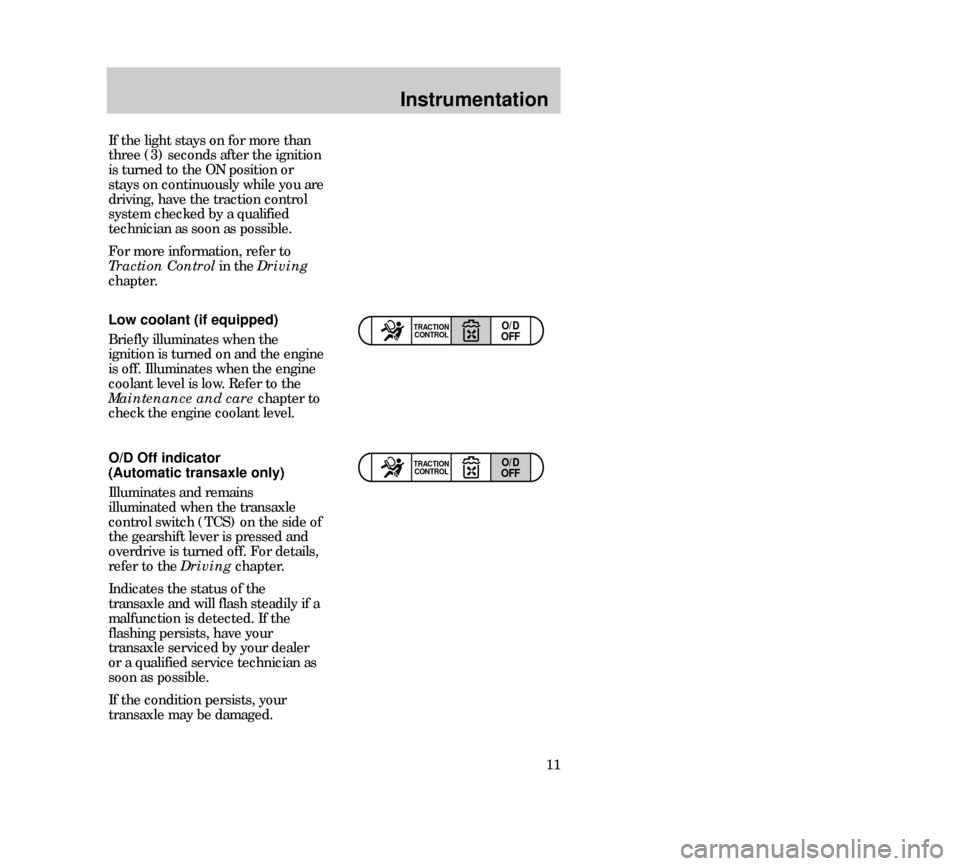
Instrumentation
11 O/D Off indicator
(Automatic transaxle only)
Illuminates and remains
illuminated when the transaxle
control switch (TCS) on the side of
the gearshift lever is pressed and
overdrive is turned off. For details,
refer to the Driving chapter.
Indicates the status of the
transaxle and will flash steadily if a
malfunction is detected. If the
flashing persists, have your
transaxle serviced by your dealer
or a qualified service technician as
soon as possible.
If the condition persists, your
transaxle may be damaged.
O/D
OFFTRACTION
CONTROL
Low coolant (if equipped)
Briefly illuminates when the
ignition is turned on and the engine
is off. Illuminates when the engine
coolant level is low. Refer to the
Maintenance and care chapter to
check the engine coolant level.O/D
OFFTRACTION
CONTROL
If the light stays on for more than
three (3) seconds after the ignition
is turned to the ON position or
stays on continuously while you are
driving, have the traction control
system checked by a qualified
technician as soon as possible.
For more information, refer to
Traction Controlin the Driving
chapter.
12MInen 24.6.99 15:03 Uhr Seite 11
Page 172 of 248

Maintenance and care
172Brake/clutch fluid reservoir
Brake and clutch fluid systems are
supplied from the same reservoir.
The level of the fluid must lie
between the MIN and MAX marks
on the side of the reservoir. If the
level falls below the MIN mark, the
brake fluid level warning light on
the instrument cluster will
illuminate. Add only DOT 3, DOT 4
or Super DOT 4 brake fluid that
meets the Ford specification (see
the chapter Capacities and
specifications).
If you use brake fluid that is not
DOT 3, DOT 4 or Super DOT 4 you
will cause permanent damage to
your brakes.
MAX
MIN
Brake fluid is toxic.
BRAKE
BRAKE
Do not let the reservoir for
the master cylinder run dry.
This may cause the brakes to fail.
Windshield washer system
If necessary, add enough washer
fluid to fill the reservoir. Follow the
instructions on the washer fluid
label.
Do not put engine coolant in
the container for the
windshield washer fluid.
Alternative design
31MMCen 24.6.99 15:30 Uhr Seite 172
Page 173 of 248
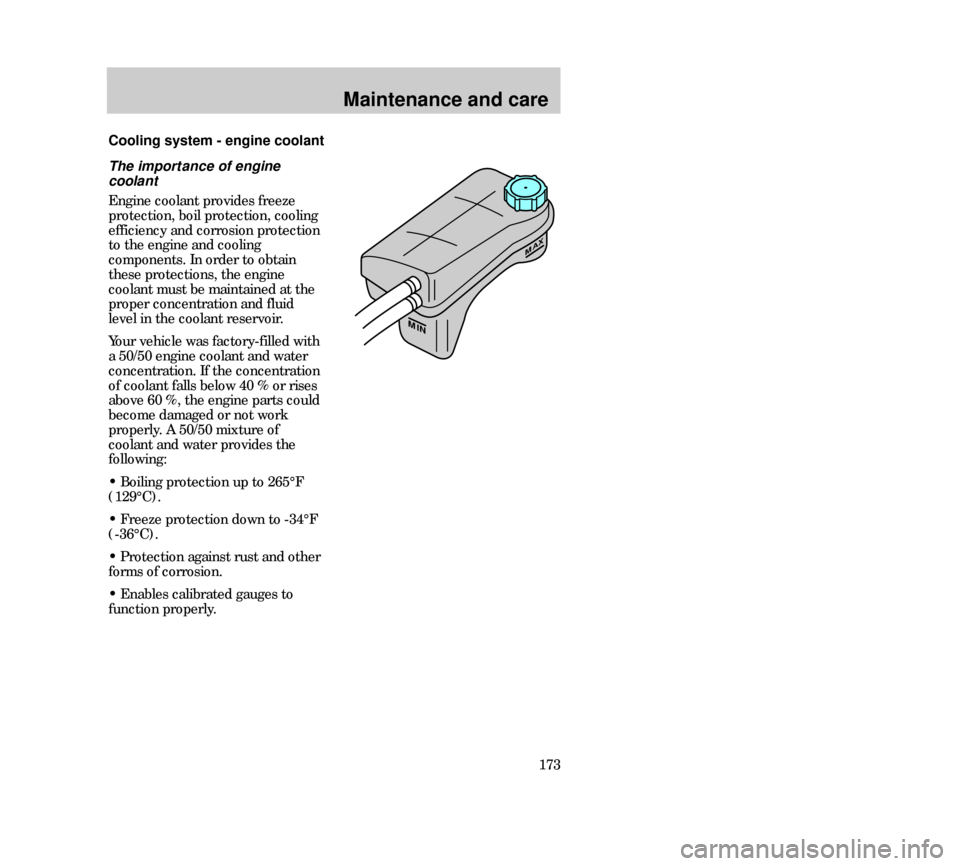
Maintenance and care
173
MAX
MIN
The importance of engine
coolant
Engine coolant provides freeze
protection, boil protection, cooling
efficiency and corrosion protection
to the engine and cooling
components. In order to obtain
these protections, the engine
coolant must be maintained at the
proper concentration and fluid
level in the coolant reservoir.
Your vehicle was factory-filled with
a 50/50 engine coolant and water
concentration. If the concentration
of coolant falls below 40 % or rises
above 60 %, the engine parts could
become damaged or not work
properly. A 50/50 mixture of
coolant and water provides the
following:
• Boiling protection up to 265°F
(129°C).
• Freeze protection down to -34°F
(-36°C).
• Protection against rust and other
forms of corrosion.
• Enables calibrated gauges to
function properly. Cooling system - engine coolant
31MMCen 24.6.99 15:30 Uhr Seite 173
Page 174 of 248
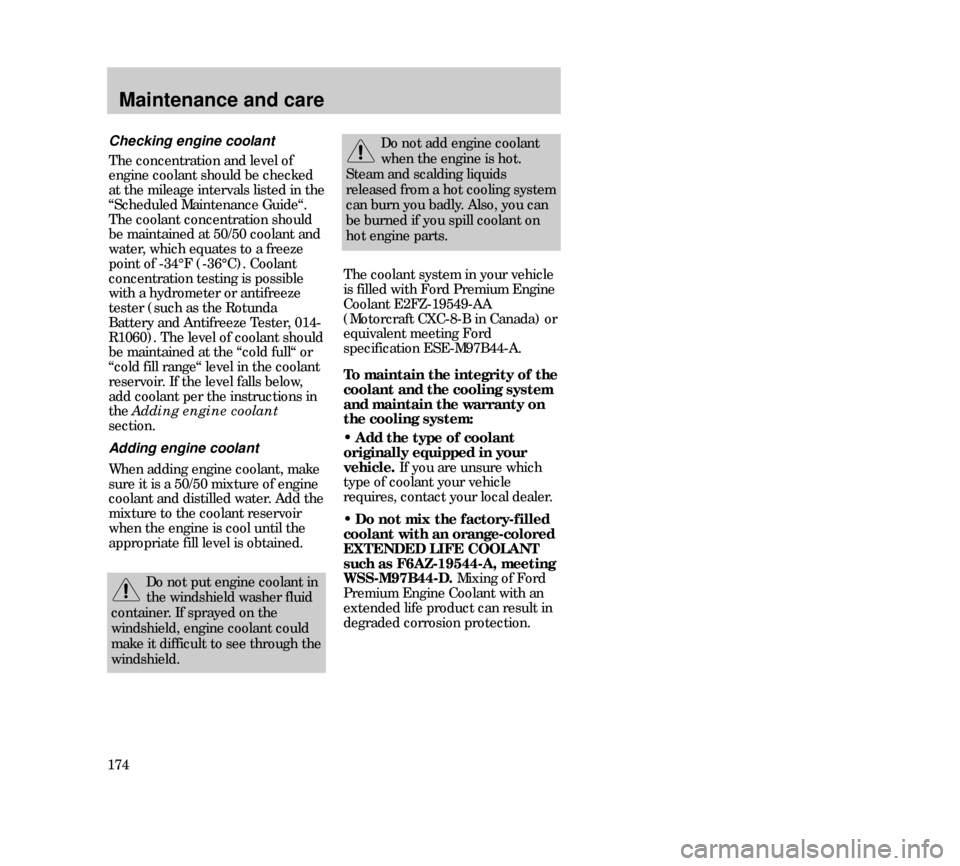
Maintenance and care
174Checking engine coolant
The concentration and level of
engine coolant should be checked
at the mileage intervals listed in the
“Scheduled Maintenance Guide“.
The coolant concentration should
be maintained at 50/50 coolant and
water, which equates to a freeze
point of -34°F (-36°C). Coolant
concentration testing is possible
with a hydrometer or antifreeze
tester (such as the Rotunda
Battery and Antifreeze Tester, 014-
R1060). The level of coolant should
be maintained at the “cold full“ or
“cold fill range“ level in the coolant
reservoir. If the level falls below,
add coolant per the instructions in
the Adding engine coolant
section.
Adding engine coolant
When adding engine coolant, make
sure it is a 50/50 mixture of engine
coolant and distilled water. Add the
mixture to the coolant reservoir
when the engine is cool until the
appropriate fill level is obtained.
Do not put engine coolant in
the windshield washer fluid
container. If sprayed on the
windshield, engine coolant could
make it difficult to see through the
windshield.
Do not add engine coolant
when the engine is hot.
Steam and scalding liquids
released from a hot cooling system
can burn you badly. Also, you can
be burned if you spill coolant on
hot engine parts.
The coolant system in your vehicle
is filled with Ford Premium Engine
Coolant E2FZ-19549-AA
(Motorcraft CXC-8-B in Canada) or
equivalent meeting Ford
specification ESE-M97B44-A.
To maintain the integrity of the
coolant and the cooling system
and maintain the warranty on
the cooling system:
•Add the type of coolant
originally equipped in your
vehicle. If you are unsure which
type of coolant your vehicle
requires, contact your local dealer.
•Do not mix the factory-filled
coolant with an orange-colored
EXTENDED LIFE COOLANT
such as F6AZ-19544-A, meeting
WSS-M97B44-D. Mixing of Ford
Premium Engine Coolant with an
extended life product can result in
degraded corrosion protection.
31MMCen 24.6.99 15:30 Uhr Seite 174
Page 176 of 248
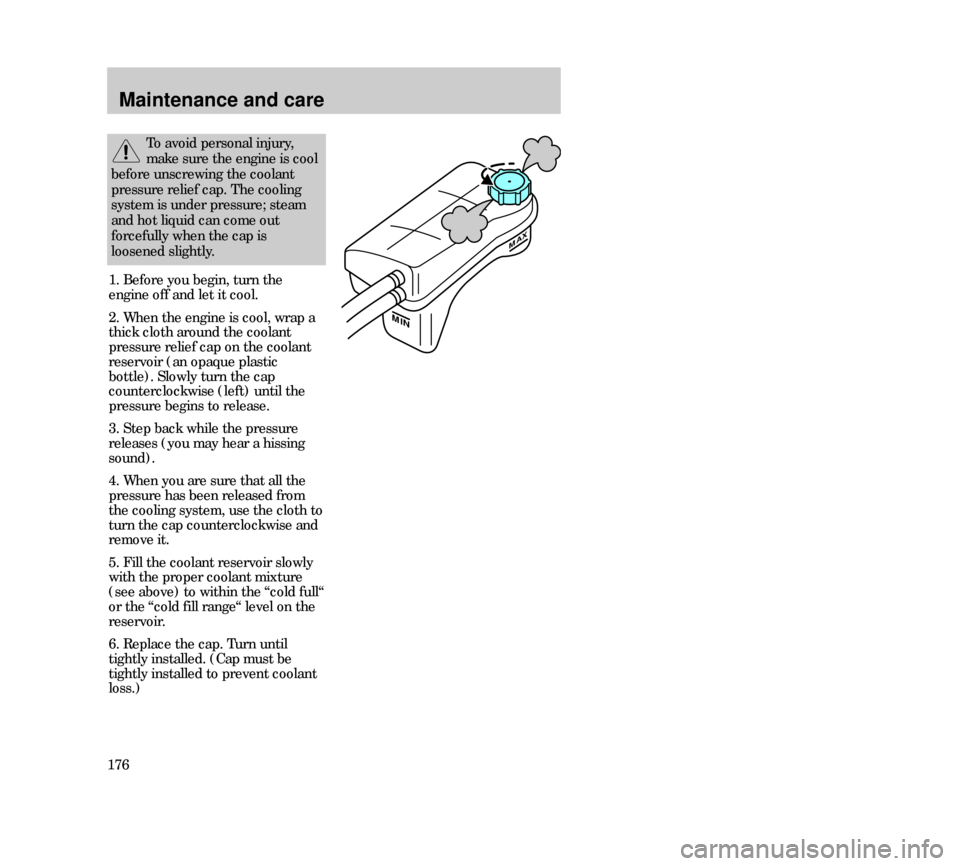
Maintenance and care
176
MAX
MIN
1. Before you begin, turn the
engine off and let it cool.
2. When the engine is cool, wrap a
thick cloth around the coolant
pressure relief cap on the coolant
reservoir (an opaque plastic
bottle). Slowly turn the cap
counterclockwise (left) until the
pressure begins to release.
3. Step back while the pressure
releases (you may hear a hissing
sound).
4. When you are sure that all the
pressure has been released from
the cooling system, use the cloth to
turn the cap counterclockwise and
remove it.
5. Fill the coolant reservoir slowly
with the proper coolant mixture
(see above) to within the “cold full“
or the “cold fill range“ level on the
reservoir.
6. Replace the cap. Turn until
tightly installed. (Cap must be
tightly installed to prevent coolant
loss.)
To avoid personal injury,
make sure the engine is cool
before unscrewing the coolant
pressure relief cap. The cooling
system is under pressure; steam
and hot liquid can come out
forcefully when the cap is
loosened slightly.
31MMCen 24.6.99 15:30 Uhr Seite 176
Page 177 of 248
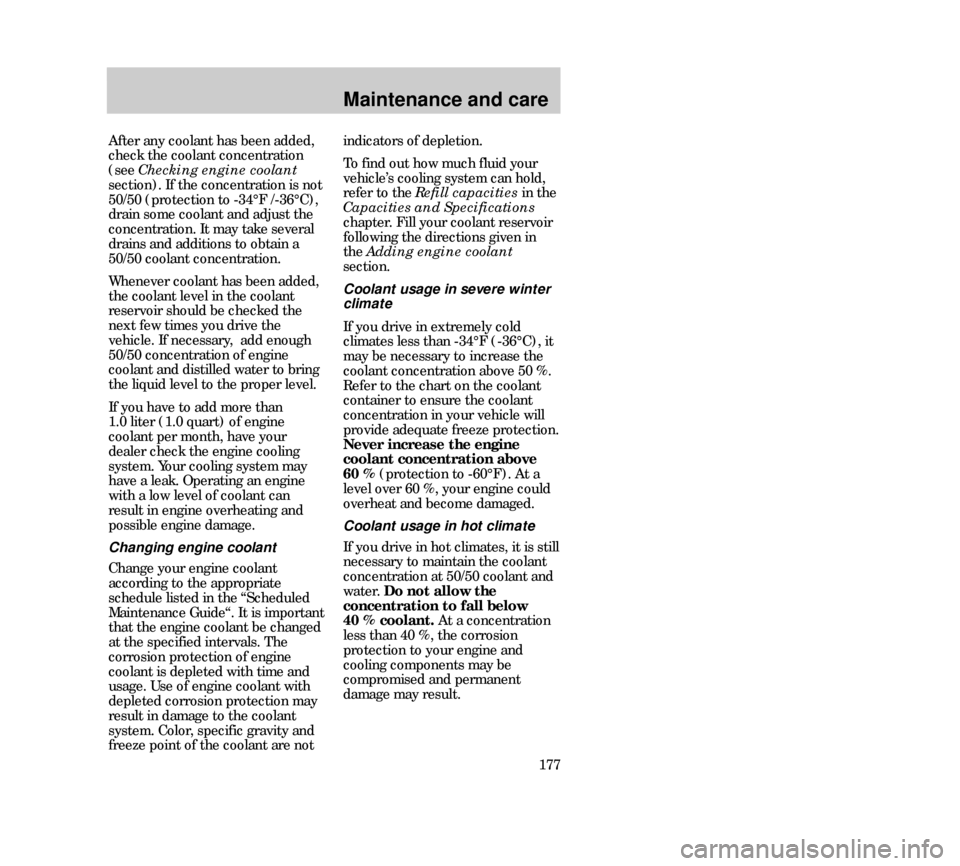
Maintenance and care
177 After any coolant has been added,
check the coolant concentration
(see Checking engine coolant
section). If the concentration is not
50/50 (protection to -34°F /-36°C),
drain some coolant and adjust the
concentration. It may take several
drains and additions to obtain a
50/50 coolant concentration.
Whenever coolant has been added,
the coolant level in the coolant
reservoir should be checked the
next few times you drive the
vehicle. If necessary, add enough
50/50 concentration of engine
coolant and distilled water to bring
the liquid level to the proper level.
If you have to add more than
1.0 liter (1.0 quart) of engine
coolant per month, have your
dealer check the engine cooling
system. Your cooling system may
have a leak. Operating an engine
with a low level of coolant can
result in engine overheating and
possible engine damage.
Changing engine coolant
Change your engine coolant
according to the appropriate
schedule listed in the “Scheduled
Maintenance Guide“. It is important
that the engine coolant be changed
at the specified intervals. The
corrosion protection of engine
coolant is depleted with time and
usage. Use of engine coolant with
depleted corrosion protection may
result in damage to the coolant
system. Color, specific gravity and
freeze point of the coolant are not indicators of depletion.
To find out how much fluid your
vehicle’s cooling system can hold,
refer to the Refill capacities in the
Capacities and Specifications
chapter. Fill your coolant reservoir
following the directions given in
the Adding engine coolant
section.
Coolant usage in severe winter
climate
If you drive in extremely cold
climates less than -34°F (-36°C), it
may be necessary to increase the
coolant concentration above 50 %.
Refer to the chart on the coolant
container to ensure the coolant
concentration in your vehicle will
provide adequate freeze protection.
Never increase the engine
coolant concentration above
60 %(protection to -60°F). At a
level over 60 %, your engine could
overheat and become damaged.
Coolant usage in hot climate
If you drive in hot climates, it is still
necessary to maintain the coolant
concentration at 50/50 coolant and
water. Do not allow the
concentration to fall below
40 % coolant.At a concentration
less than 40 %, the corrosion
protection to your engine and
cooling components may be
compromised and permanent
damage may result.
31MMCen 24.6.99 15:30 Uhr Seite 177
Page 178 of 248

Maintenance and care
178
Checking and adding power
steering fluid
Switch off the engine. With the
steering system at normal
operating temperature, the fluid
level should come up to the MAX
mark.
If the fluid level drops below the
MIN mark, add the specified fluid.
Refer to the Capacities and
specificationschapter.MAX
MIN Disposal of used engine coolant
Used engine coolant should be
disposed of in an appropriate
manner. Follow your community’s
regulations and standards for
recycling and/or disposal of
automotive fluids. Use of recycled engine coolant
Ford Motor Company recommends
the use of recycled engine coolant
produced by Ford-approved
processes. However, not all coolant
recycling processes produce
coolant that meets Ford
specification ESE-M97B44A. Use of
such coolant may harm the engine
and coolant system components.
31MMCen 24.6.99 15:30 Uhr Seite 178